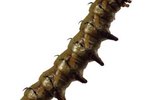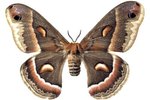
When you've accidentally touched a moth or grabbed one to toss him outside at night, the insect likely left a bit of himself behind: dust from his wings. This dust is actually tiny scales that serve multiple functions for the moth. Losing a few scales won't hurt him, but it's best not to handle a moth because you could hurt his wings along with rubbing off the dust.
Camouflage
A moth's scales, which are actually tiny hairs, help create the sometimes intricate patterns you see on his wings. These patterns typically appear in dull colors such as brown and black. Most moths fly at night and sleep during the day, so they don't need the bright colors of butterflies. The dull colors help a moth camouflage himself as he rests during the day, allowing him to blend in as he sits on a tree branch or among the brush.
Warmth
Because a moth is most active at night, he need a little help to stay warm while the sun's down. The scales provide an insulating layer to help the moth stay warm. A butterfly uses scales for thermoregulation as well, but a moth tends to have thicker scale layers. Without the ability to heat up in the sun's rays, a moth needs extra insulation.
Dating
Even though his colors are dull, a moth needs the right combination of colors and patterns to attract a mate. Male and female moths follow pheromone trails to help them find mates, but the visual cues are key when they get close enough to spot each other. When many scales are missing, the moth can still fly but he might not be able to attract a mate.
Losing Scales
The dust comes off a moth's wings easily. He loses a few scales every time he flies or lands on a flower to feed; even windy weather can remove them. Although the scales help slightly with aerodynamics, they aren't essential to flight, so a moth can still get around even when missing most of his scales. When you touch a moth, the danger isn't that you might remove his scales, it's that you can easily harm his delicate wings without realizing it. Avoid touching a moth if possible.
References
Photo Credits
-
Stockbyte/Stockbyte/Getty Images




